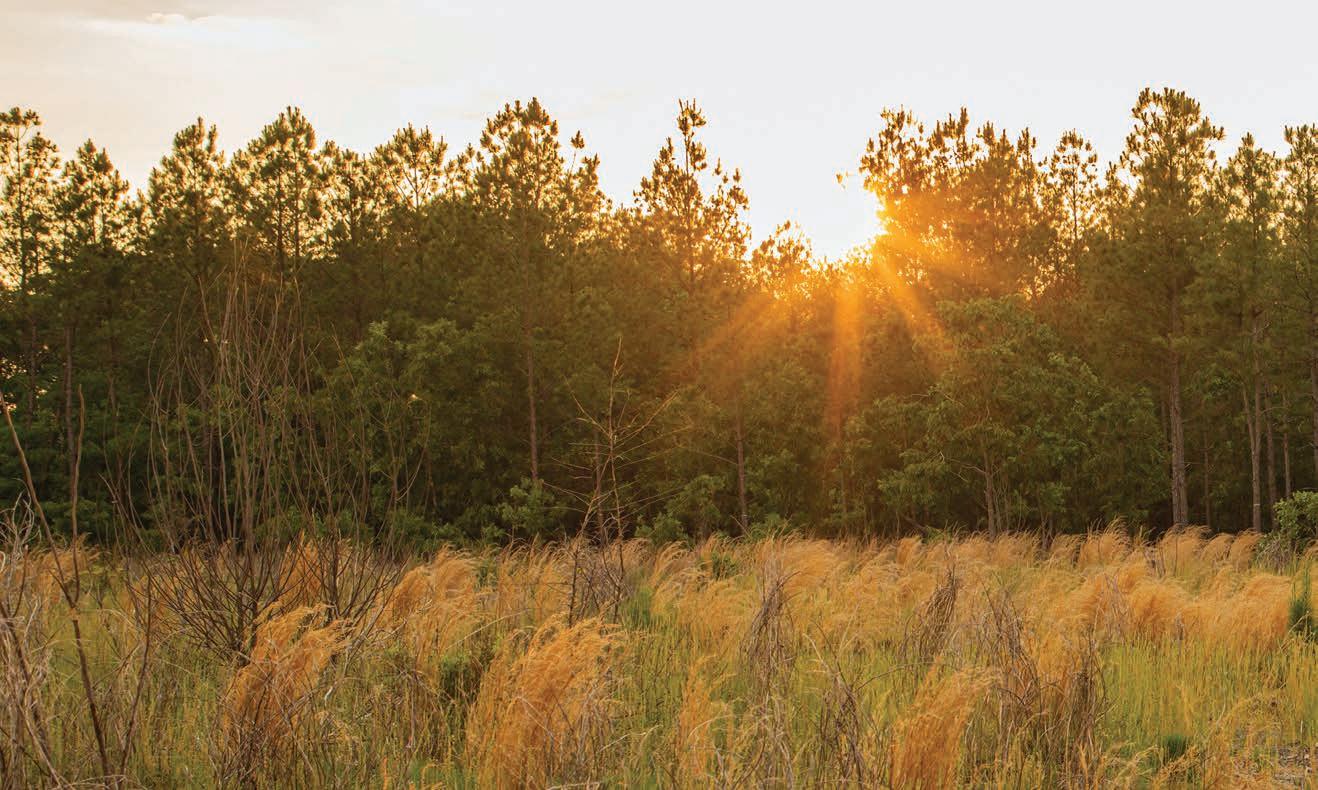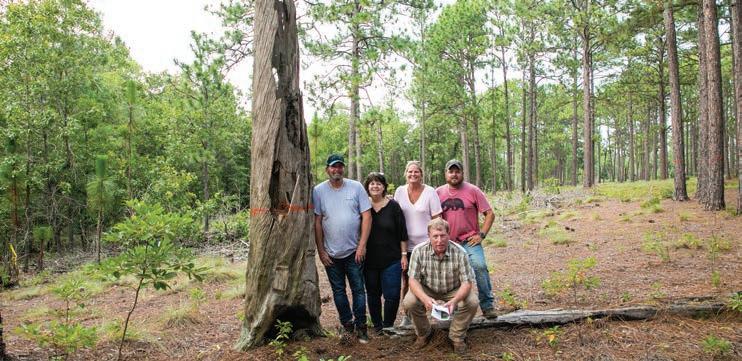
5 minute read
LANDOWNER CORNER
The grasses and forbs that make up the groundcover add species diversity to the developing forest and supply the fuels needed for prescribed fires.
utilizing longleaf restoration tools
Advertisement

in the North Carolina Sandhills
By Carol Denhof, The Longleaf Alliance
The once abundant longleaf pine forests of North Carolina are much depleted due to the long-term effects of resin collection, overharvesting of trees, and lack of management with prescribed fire. Fortunately, there are landowners across the state who are bringing back this ecosystem.
As they begin their longleaf restoration journey, landowners often face overgrown properties with a long history of fire exclusion and an abundance of woody plants in the understory instead of desirable native groundcover. To reach their full potential as working forests with longleaf's characteristic open and park-like structure, timber harvests and prescribed fire are essential management tools for restoring stands and ensuring forest health.
On some sites, one harvesting strategy available is fuel chipping – a tool to remove undesirable hardwoods and pines to kickstart longleaf restoration while also providing income to the landowner. This income helps the landowner to push forward with management practices, bringing them closer to achieving their restoration goals.
What is Fuel Chipping?
Fuel chipping is when low-quality wood is chipped and processed to form pellets for energy. Companies like our partner Enviva, a global renewable energy company specializing in sustainably sourced biomass, begin their process by sourcing the most sustainable raw materials, including fiber from low-value wood, tops and limbs, thinnings, and mill residues. These materials typically would be left behind or burned in the field to make way for the next generation of lumber-grade timber.
“Being able to sell low-grade hardwood for pellets has helped my clients manage their property. When the chip market came along, we had a by-product to generate income to help the restoration process plus clean up a lot of the midstory, remove loblolly, and leave the longleaf in place. Some projects would not happened without being able to get rid of that by-product,” said David Halley, consulting forester with True North Management Services.
First-hand restoration examples are important learning tools for those working to restore longleaf pine forests. Meet two North Carolina landowners, Ann Rogers and Hand Me Down Farms, who share their experiences restoring longleaf and how fuel-chipping helped.
Ann Rogers
Ann Rogers is a landowner in Montgomery County, North Carolina. Her unique property is located on the fall-line between the Coastal Plain and Piedmont regions of the state and has been in Ann's family for multiple generations. After inheriting the property, she is working to restore the longleaf pine ecosystem by thinning, planting, and burning with the goal of permanently protecting the land through a conservation easement. Fuel chipping has been utilized in the thinning process and provides some income that helps fund other work on the property.

Ann Rogers, Montgomery County, North Carolina
Originally, I didn’t have a goal for the property until I learned about longleaf. I was thrilled to know that something good could come from this, and these 200 acres would never have concrete on them. - Ann Rogers


Family members meet with their forester and others to discuss management options at Hand Me Down Farms. A ~200-year-old pine stump shows evidence of turpentining at Hand Me Down Farms.

Photos courtesy of Eniva
Hand Me Down Farms
Hand Me Down Farms in the Sandhills of North Carolina is collectively owned by siblings Christina Williams Smith, Teresa Williams Byers, and Tracy Williams OvertonPritchard as an LLC. Because of his farming experience, George Byers (husband to Teresa) has taken on the farm and land manager role. The family has learned about the benefits of longleaf and its history on their land and actively manages the forested areas with prescribed fire to enhance the ecosystem. Hand Me Down Farms is an active member of the Sandhills Prescribed Burn Association that engages landowners to work together to return fire to the landscape.
Additionally, they are in the process of restoring 50 acres of longleaf pine habitat on their property. A combination of canopy, understory thinning, and fuel chipping has reduced competition for the trees and native groundcover, promoting a healthy ecosystem. By working closely with a network of foresters, loggers, and other partners, they can convert what was once land that was difficult to manage into a healthy forest system that supports the many plant and animal species that call the longleaf ecosystem their home.
The three girls lived here all their lives, and they saw the property grow up over time. When we started talking about thinning, they weren’t sure that’s what they wanted to see. Once it happened, it was very clear to them that things looked much better. Now you can sit in the center of the farm with a 360-degree view. They are proud we were able to do that while preserving what their grandparents and parents worked so hard to do. – George Byers

The Longleaf Alliance is working in partnership with Enviva to bring these additional tools to landowners focused on longleaf restoration. If you think this process could help you on your land and are interested in learning more about this longleaf restoration opportunity, please send a message to sustainability@envivabiomass.com.

Maximizing restoration potential
When managing working forests, like many privately owned properties where longleaf pine occurs in the southeastern United States, it is important to look at all available tools to maximize restoration outcomes. If these strategies also bring some income to help with the process,
Stand prior to treatment with a dense scrub oak midstory. This overly thick growth inhibits healthy herbaceous groundcover and regeneration of longleaf pine. By resetting the midstory, the site will open up, and sunlight will hit the ground and encourage a diverse groundcover release.
that is even better for the landowner. In the long run, by using harvesting tools like fuel chipping and other management activities to improve forest health, landowners will see their land as an asset that provides value on many levels and is worth keeping intact for the next generation.












